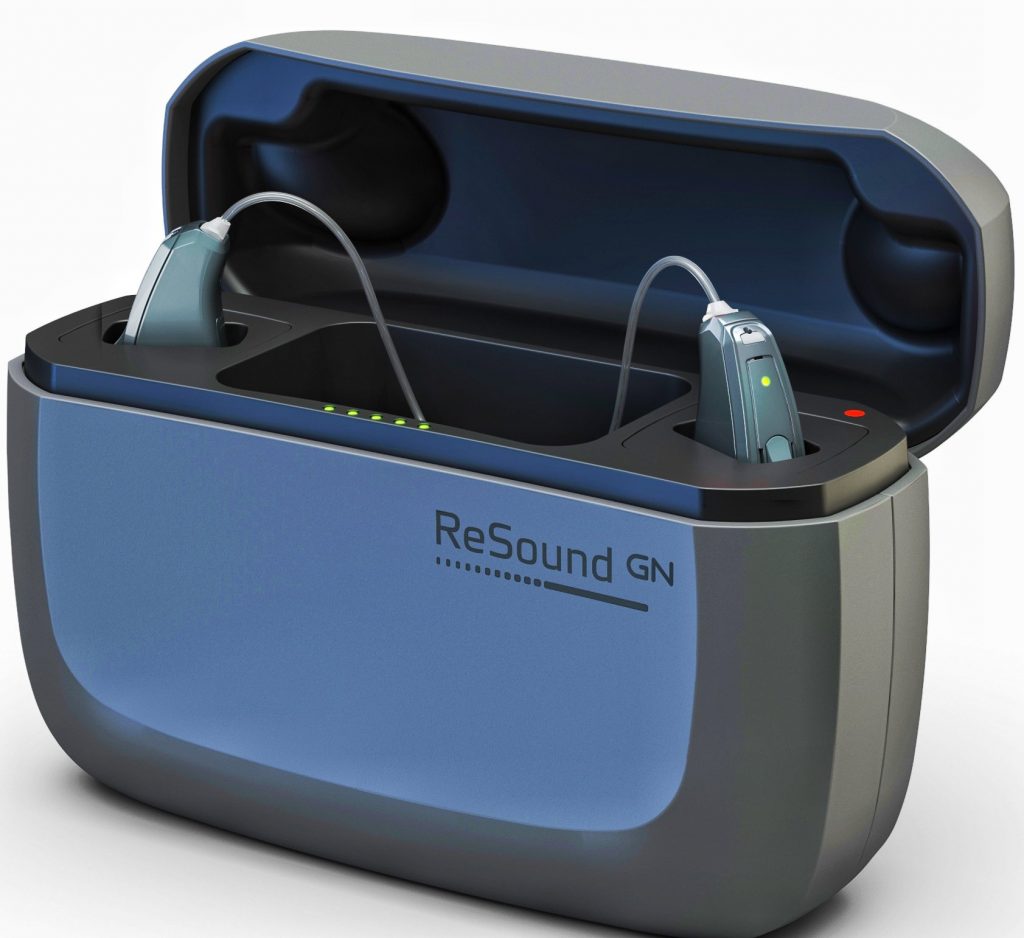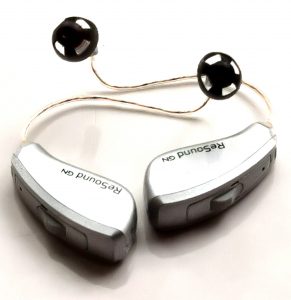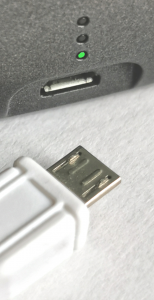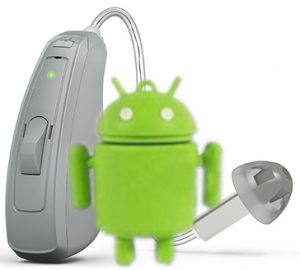This is the third hearing aid review Tested Technology has undertaken in the past couple of years. Readers may be wondering why we’re paying so much attention to this niche market. Fair enough. Let’s deal with that question.
- It’s not the niche business you might think. In 2017 the global market for hearing devices was estimated to be worth a little under $6.5 billion and is expected to reach over $9 billion in the next five years. Demand is increasing, but more importantly, the need is increasing even faster. This need will turn to demand at an accelerating rate as the price of the technology falls.
- Falling prices will be driven by three main factors: the inevitable declining cost of technological components; the widening market for medical hearing devices; and—as we discussed in our initial review of the Teneo M+ hearing aids—the merging of the medical hearing aid market with the now rapidly evolving “hearable” consumer market.
- Technological advances from the hearing aid manufacturers (like NFMI and balanced armature microphones and speakers) have already crossed over into consumer devices. These technologies and others currently in development in the medical field are arriving inside products anybody, hearing-impaired or not, can benefit from. By tracking these hearing aid developments Tested Technology hopes to give readers an informed glimpse of the future.

I RAN INTO RESOUND AT THE VAST IFA technology Expo in Berlin last year. ReSound is a worldwide Danish manufacturer of medical hearing equipment under the ownership of GN Store Nord, a venerable firm founded in 1869 as “Det Store Nordiske Telegrafselskab A/S”, which translates as “The Great Northern Telegraph Company”.
As a communication technology, the telegraph, alongside (often literally) the railway infrastructure, dominated the second half of the 19th century. GN’s global reach grew rapidly. By the 1920s it had established a name for itself as one of only a handful of world-class telecommunication companies.
When the Second World War physically and metaphorically destroyed GN’s telegraph business, the company began to diversify into other related fields. By the end of the 20th century, GN was left focussing on just two core businesses: hearing aids and headsets, produced by GN Hearing and GN Audio.
The ReSound LiNX Quattro*

With the launch in November 2018 and the showing at the Consumer Electronics Show in January of this year, ReSound introduced the new LiNX Quattro. The improved chipset is built around a much faster processor able to handle a wider range of high-frequency sounds.
This extended frequency—now up to 9.5 kHz—not only gives a fuller and more balanced rendering of music but, more importantly, provides more of the high-frequency cues that are valuable for better speech recognition.
On paper, 9.5kHz may not look impressive as the frequency ceiling. Hearing aid microphones and electronics have been able to cope with high frequencies for several years. The Sivanto Teneo M+, for example, could be controlled by inaudible ultrasound frequencies sent from a smartphone.
Textbooks quote 20Hz to 20kHz as the range of human hearing. Each doubling of frequency represents an octave, so at 9.5kHz the Quattros are still missing just over one full top octave.
However, those textbook metrics are largely theoretical. The human ear is most sensitive in the 2kHz to 5kHz range. From the age of 8 years onwards we experience loss of those upper frequencies and very few adults reach middle age with the ability clearly to hear sounds above 15kHz. Male hearing tends to deteriorate faster than female hearing.
To put that in perspective, 9.5kHz is roughly B below high C on the piano and 12kHz is four chromatic notes higher at approximately D#.
![]()
Traditionally, audiologists have focused entirely on the 120Hz to 8kHz range, crucial to speech recognition. Digital hearing aids have typically been designed accordingly, not only shortchanging musicians and music lovers, but also—as mentioned—depriving the general user of possibly useful high-frequency speech cues.
To be fair, there has been sensible science behind this limitation. There is no point amplifying frequencies that the impaired cochlea may be unable to deal with at any volume. And in any case, high frequency speech cues, most useful in noisy environments, can easily be drowned out by amplified noise in that same frequency range.
But ReSound is now able to venture usefully into these higher frequencies with the LiNX Quattro, thanks to two technological developments that have been transforming the hearing aid industry in general since the beginning of this century: frequency transposition and greatly improved speech in noise separation thanks to much better sound location.
ReSound calls this transposition “Sound Shaper”. It’s a similar strategy to the frequency compression used in the Teneo M+ . ReSound explains:
High-frequency sounds that are not audible due to high-frequency losses or cochlear dead regions are moved down in the frequency spectrum. A proportional relationship between input and output frequencies is maintained to minimise distortion.
This improves the audibility of speech cues that would otherwise have been lost, while maintaining the best sound quality possible.
More Juice, Longer Use
One immediately impressive feature of the LiNX Quattro is rechargeability. Instead of having to open the battery cases to switch them off at night, and periodically to remove the disposable batteries and replace them with new ones, you simply ensure that the built-in batteries are refreshed before they run down.
What makes this so important?
NFMI and Telecoil both allow for highly energy efficient short-range communication. But more recently, with the ubiquity of smartphones, hearing aid manufacturers have vied with one another to include Bluetooth for more general connectivity.
The Evotion Oticon uses Bluetooth to communicate with the Evotion-provided Samsung A3 smartphone so that usage data can be conveyed back to the Big Data pool the project is collecting. These hearing aids run on disposable zinc-air 312 batteries for an absolute maximum of five days. My previous hearing aids, the Teneo M+ (admittedly using the slightly larger size 13 battery) would run happily for up to 11 days between changes. These did not use Bluetooth.
Zinc-air is a remarkable technology and weight-for-weight has a much higher energy density than the Li-ion chemistry that fuels rechargeables.*
ReSound’s LiNX Quatto ingeniously works around this problem with three key design decisions.
- Don’t pursue the trend to ever smaller devices. Build the hearing aids around sensibly sized rechargeables (approximately size 13 equivalents) that can hold a whole day’s charge.
- Provide a “seamless” charging solution that is as simple as returning the hearing aids to their case.
- Build the case itself around a much larger rechargeable battery, making it fully portable and independent of the mains supply.
(There’s a fourth consideration around how the manufacturer chooses to implement Bluetooth. We’ll come to that later.)
The batteries in these small devices recharge automatically and wirelessly every time you return them to the case. The case itself contains its own rechargeable battery, which in turn can be recharged through a standard microUSB connector. The hearing aids can run for more than a full day on a single charge and the case holds several days worth of recharging power.
An update from ReSound says:
We have also recently changed the battery in the hearing aid charger. Initial tests show the charger can recharge two hearing aids four times before it runs out. The new battery takes 3.5 hours to charge from completely empty.
Normally, one might expect to keep the charging case on a bedside table, where it can remain permanently attached to its USB charging device. This was the arrangement I used initially for several months.
But this revised claim from GN that an improved battery in the charging case can fully recharge the LiNX Quattro four times before it needs to be reconnected to its charger piqued my interest. The charging case remained on my bedside table—but I removed the microUSB plug.
 I had assumed that this “recharge four times” claim meant I would have to reconnect the charging case every four days. So I was very surprised to discover that the charging case continued to charge the hearing aids night after night for an entire week. This was with the LiNX Quattro being worn for at least 10 hours a day, with an average of around three hours of Bluetooth streaming per day (using the intermediate devices described later).
I had assumed that this “recharge four times” claim meant I would have to reconnect the charging case every four days. So I was very surprised to discover that the charging case continued to charge the hearing aids night after night for an entire week. This was with the LiNX Quattro being worn for at least 10 hours a day, with an average of around three hours of Bluetooth streaming per day (using the intermediate devices described later).
At the end of the week, the three LEDs at the back of the box, indicating its own charge, had dropped to a single LED. I took this as a sign to reconnect the USB charger. But it’s very probable that enough juice was left for at least another day’s charge of the hearing aids. Does this mean the marketing claim of four days was wrong by a factor of 100%?
My mistake was equating “recharge two hearing aids four times” with “four days charge”. Yes, if you manage to run down the LiNX Quattro fully each day, this is probably a fair equation. But the remarkable charge capacity of the hearing aids themselves meant that at the end of each day the indicator LEDs that light up on return to the case showed the LiNX Quattro to have lost less than half their full charge.
I obviously should be working much longer hours per day and listening to a lot more music.
Made for Android?

At its first announcement (as reported here by hearing aid blogger Geoff Cooling) the LiNX Quatto was described as “the first ever to be Made for Android”. The idea was that Android users would at last be able to join the iPhone crowd, who for a couple of years now have been able to stream audio directly from their phones to the hearing aids of several different manufacturers with no intermediate device.
The “Made for Android” label came with some qualifications. ReSound is “in partnership with Google” about this, from which we can gather that direct streaming of this kind requires a special variant of the normal Bluetooth protocol that isn’t yet rolled out into Android devices.
In choosing this route, Sonova inevitably sacrifices battery longevity. It remains to be seen whether further updates to the Marvel firmware will be able to incorporate ASHA when it becomes available.
One key function missing from BLE is audio streaming. This is why hearing aids like the Oticon Evotion can be controlled from a smartphone app via Bluetooth, but can’t directly receive music or speech. It’s what makes intermediate devices like the easyTek neck loop and ReSound’s Phone Clip+* necessary.
Work is being conducted within the Bluetooth SIG (Special Interest Group) among the big hearing aid manufacturers to standardise on one solution available in all Bluetooth devices, but timing of this effort is currently unknown. You can read more here.
The initial date for direct streaming to Android was thought to be mid-2019. At the time of writing, we’re still waiting to hear from ReSound about this and the official information is that there’s no official information when this might be.
You can get the full (very technical) heads-up on Audio Streaming for Hearing Aids from Android’s own Web page.
In the next part of this review, we’ll be looking at the various intermediate streaming devices that connect LiNX Quattro users wirelessly to their TVs and phones and also provide the very best way of hearing speech in noisy surroundings.
Chris Bidmead

excellent review – am using specsavers ‘crippled’ quattros, but intend upgrading next month.
would be happy if android and resoud were more forthcoming about where we stand, but i suppose any progress will be in their own time…
looking forward to part two…
Thanks, Leslie. Yes, I’m keen to know where we’re going with ASHA too. My sense is that we won’t have to wait too long now.
—
Chris
why can’t I have control of my tone settings at home in my environment I am sick of having an adjustment in a room with smooth surfaces only to get home and find out the settings are all wrong and then wait months for another appointment and travel a great distance from rural area to nearest technician , while it’s great to adjust volume and programs I need to be able to adjust my tone for my situation of my Unitron aids.
Tony, there was a firmware upgrade to the LiNX Quatto earlier this month (December). Have you installed this? And there’s a new version of the (Android) app. Under More at the bottom of the app’s main page, you’ll find “Auto-activate favourite locations”. Have you explored this option?
–
Chris
I opted for the traditional “13” battery model over the rechargeable for a couple of reasons.
If you have replaceable batteries and one is dead, you replace it and voila, you can hear. If you find your battery is dead (maybe you forgot to put it in the charger, maybe you didn’t get it seated right, etc.), you can’t hear until it is done recharging. A friend of a friend likes to listen to audio books (her eyesight as well as hearing is diminished), and these batteries just don’t have enough life to do that kind of streaming all day. You’re just thinking in terms of music.
More importantly, however, is … planned obsolescence. They estimate about 3 years of life out of the batteries. So 3 years later I replace the batteries, but 3 years after that … “we don’t make those batteries anymore, you have to buy new hearing aids.” The company that wants to sell you new hearing aids gets to decide when you can no longer buy replacement batteries for your existing ones. I have a perfectly good GPS which I love (has a few features the new ones don’t) that’s in the same scenario – my battery is shot and I can’t get a new one (and you have to run on batteries, for no apparent reason, when you download new maps, so I can’t update the maps in it). Sadly, rechargeable batteries, and the the benefits that make them alluring, have become the latest way for technologies manufacturers to plan obsolesce.
The replacement rechargeable batteries run around $400 – I think over the course of 3 years, I just might use $400 worth of “13” size batteries, so if you think rechargeables save you money, it’s probably more of a wash.
As great as the rechargeable batteries sound on paper, I think it will take 5-10 years to see how short of the hype the reality ends up being. I suspect they will fall very short.
I hear you, Garry. Yes and no.
What you call “replaceable batteries” I prefer to call “primary batteries”. You’ll see why in a moment.
Zinc-air primary batteries are certainly amazing. Their power-to-weight ratio wipes the floor with any rechargeables around at the moment. I was having to change the Evotion’s 312s only every five days and the 13s in the Teneo M+ ran for over a week. As you suggest, the LiNX Quattro needs to be recharged daily.
But I’m still sold on the idea of rechargeables. Even with a great deal of daily streaming (using the various ReSound intermediate devices) I still end up with a 2/5 reserve at the end of the day. I always recharge overnight but on the odd occasion when I’ve forgotten to do this I’ve found that half an hour in the charger gives enough power for several hours of running time. And there’s absolutely no comparison between the ease of dropping the LiNXes into their recharging case each night and the fiddle of swapping 312s every week.
With the advent of ASHA I expect the streaming run time of rechargeables to get even longer. I’m hoping to be able to test this in the next episode of the LiNX Quattro review.
The question you raise about “planned obsolescence” is certainly worth pondering. Back in the days of the early smartphones (I’m thinking particularly of the very first Samsung Galaxy Note), batteries were rechargeable—but also REPLACEABLE. Rechargeable batteries aren’t inherently doomed to be entombed. It’s just that three things were happening to the industry at about that time.
Technology developments were accelerating, suggesting that smartphones would clearly be obsolete within five or so years and the overall life of rechargeable batteries was being extended enough to approach that vanishing point. At the same time, manufacturers perceived (in my own case, wrongly) that customers were looking for ever slimmer form factors, a promise that could only be delivered by glueing the battery semi-permanently inside the case.
Other products (eg, hearing aids and, as you suggest, satnavs) followed that lead.
So I wouldn’t say that obsolescence was a deliberate cynical manufacture decision in this case. And with greener sentiments beginning to prevail we may see the return of the replaceable rechargeable battery. It’s certainly feasible even in tiny devices like hearing aids. There’s no reason why they shouldn’t also be standard sizes, even physically the same as the 13s and the 312s.
That $400 you mention would be the full price of servicing the exchange—opening up the hearing aids, swapping out the battery and resealing to the required dust and liquid proofing standard. The major part of that price would be labour as there’s little that’s inherently costly about the chemistry of rechargeable batteries. The market for hearing aids is expanding rapidly (particularly if you include the new “hearable” category of universal wireless earpieces using much the same technology) and we can expect all these prices to come down over the next five or so years.
So, bottom line, Garry, you and I disagree about the future of rechargeable hearing aids. Let’s see what happens.
–
Chris